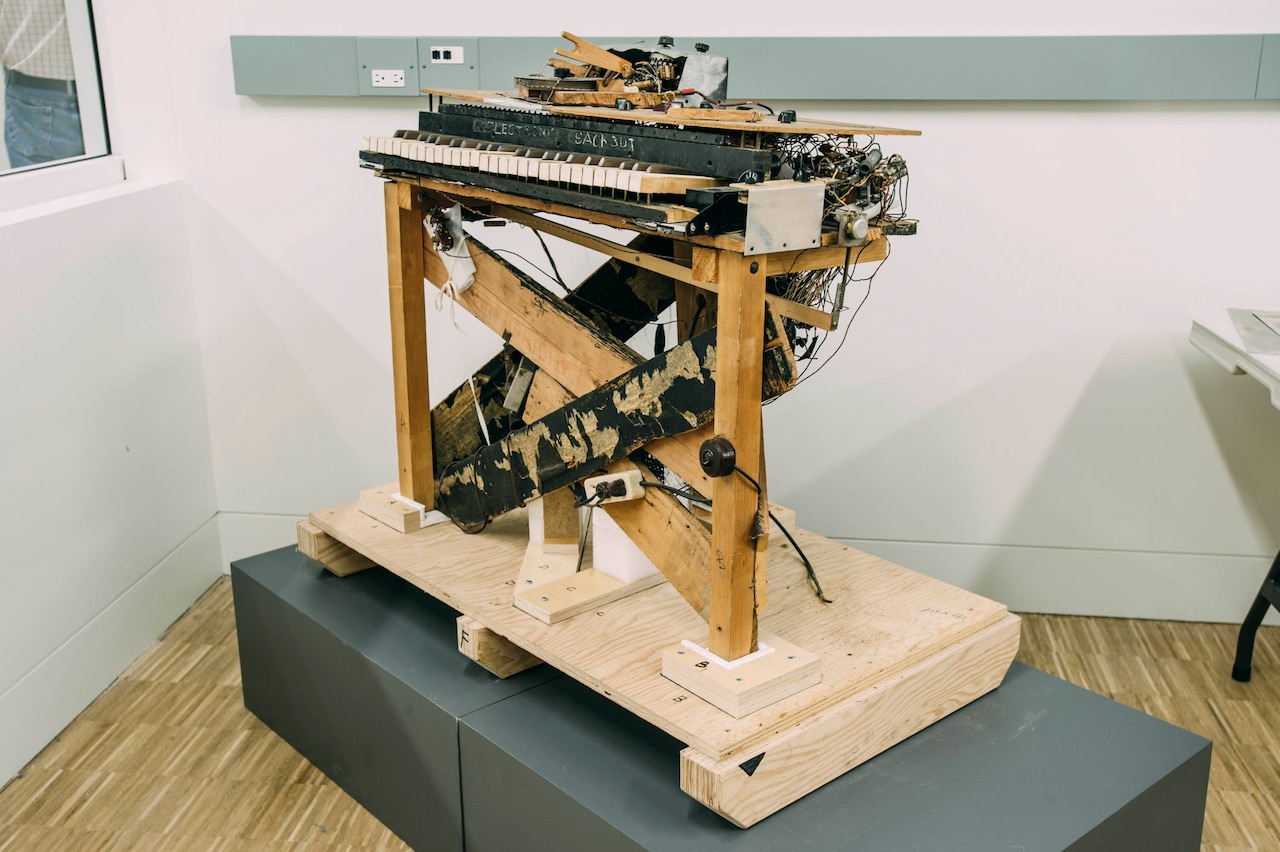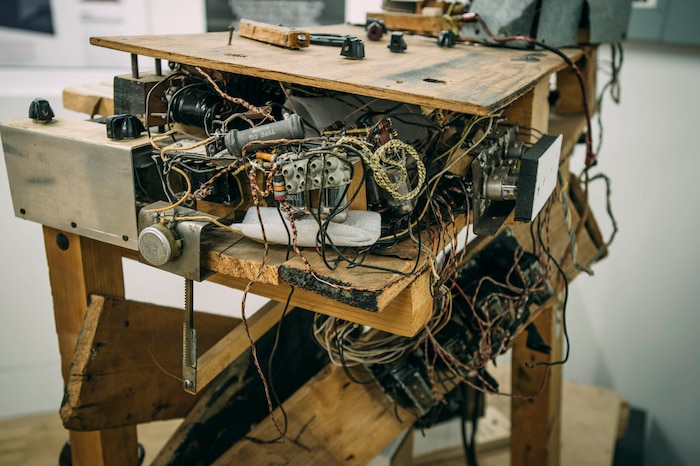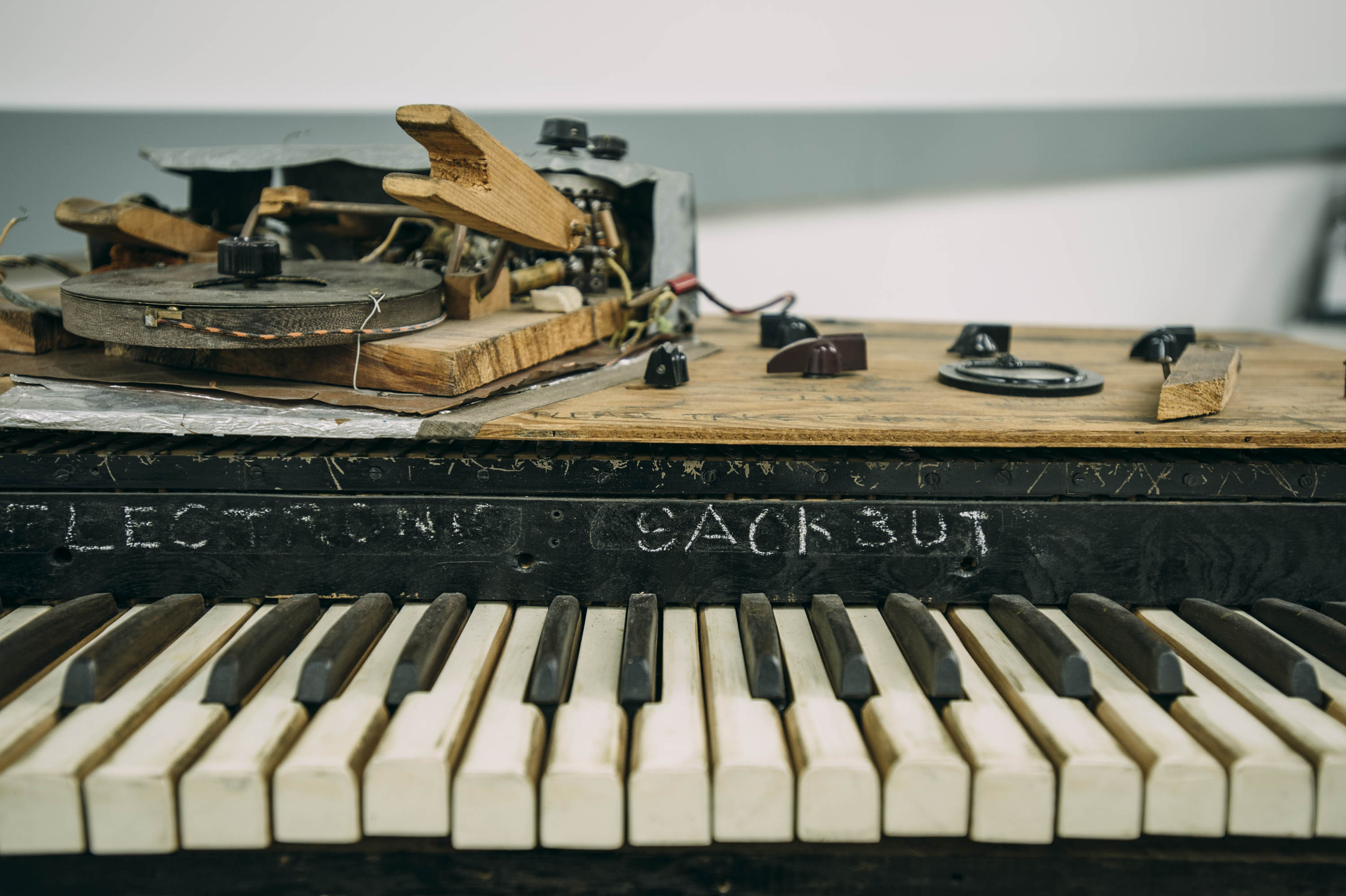
Hugh Le Caine
Kicking off our series of features on early electronic music pioneers in Canada, we focus on the inventor, scientist and composer
Hugh Le Caine was a Canadian inventor, scientist and composer who struck a rare balance between music and science, and felt at ease in laboratories where electronics and physics met classical composition and electroacoustic curiosities. Today, his visions are a reality, from touch-sensitive polyphonic synthesizers to expanding university electroacoustic departments. All those fearless ways contemporary artists engage with new digital technologies, and how they move past perceived limitations into ever-shifting sound worlds, have benefited from the example of Le Caine’s multi-faceted career as engineer, academic and musician.
The Inventor
Ahead of his time, or slightly outside of it, Le Caine stood out among his contemporaries in electronic music for inventing extremely sophisticated instruments. But he also stood out for what he didn’t possess: a classical, academic music education. By his own admission, he wasn’t a great pianist. Yet he had a knack for creating instruments – rumor has it that he built his first in 1918, at the age of four, though we know that his first officially documented invention came in 1937, when he designed an electronic free-reed organ while studying physics at Queens University.
During the Second World War, Le Caine went to work for the National Research Council of Canada in Ottawa in the fields of nuclear science and radar technology, all the while experimenting with electronics and sound possibilities. Obsessed with new, expressive sounds culled from the invisible, Le Caine's explorations plumbed the typically inaudible depths of electronics. Not only did he invent over 22 electronic instruments in 30 years, he also carved out all his compositions on them. And, if that wasn’t enough, he was a speed demon on a motorcycle, intent on beating his own records as he traveled between electronic music studios in Ottawa, Toronto and Montréal – and to his hometown of Thunder Bay.


In his home studio between 1945 and 1948, Le Caine fixated on musical instruments, using his knowledge of atomic physics, radar and radio technology to develop the Electronic Sackbut, the first voltage-controlled synthesizer. At a glance, the one surviving prototype looks like a homemade piano built with discarded wood and too many radio parts, electronic circuitry tumbling out the sides.
What the instrument lacked in sleek exterior, it made up for in sound, function and performance capabilities. Today, it stands as the monophonic prototype for many commercial synthesizers. The Sackbut’s keyboard was sensitive to vertical pressure that altered volume and vibration, while lateral motions on the keys produced changes in pitch capable of vibrato. Pressure-sensitive controls, including a circular waveform control device, changed the sound’s timbre and other textures.
This purposely designed “playability” gave Le Caine’s inventions life outside his studio. They weren’t simply devices of engineering – as so many early electronic machines tended to be. They inspired music: “His fixation with ‘beautiful sound’ led him repeatedly to design electronic instruments capable of producing a nuance-filled expression typical of the orchestral tradition,” writes another heralded and prolific Canadian composer, Gayle Young, in her 1991 Le Caine biography The Sackbut Blues.
By 1954, armed with a newly acquired graduate degree in physics, Le Caine had his own music lab at the National Research Council. Within the next decade, he co-founded electronic music studios at the University of Toronto and Montréal’s McGill University. In these environs, he would develop 20 more instruments, among them the first truly touch-sensitive polyphonic keyboard; the “Special Purpose Tape Recorder,” the first variable speed multi-track tape recorder featuring an often-used spring reverb; the “Spectrogram” light-sensitive controller; the “Serial Sound Structure Generator,” a precursor to the modern sequencer that was designed around the concept of 12-tone serial music; and an instrument called the “Sonde” that used 30 oscillators to generate 200 sine tones.
In 1970, Le Caine made a return to keyboard instruments with the fully voltage-controlled Polyphonic Synthesizer (or Polyphone) – at the time the most comprehensive analogue synthesizer ever created. Built at McGill, the synth’s keys each had their own waveform and pitch controls in addition to a separate control panel above the keyboard and foot pedals with light-sensitive controls.
With commercial production in mind, in 1971 he updated the Sackbut using integrated circuits, expanding it to seven octaves. That prototype never made it into production, yet his final instrument, the Paramus, initiated at the NRC in 1972 shortly before his retirement, heralded the future of compact synthesizers: a hybrid digital-analog four-voice polyphonic synth, it used a computer system to control analog sound generators.
The Academic
At the National Research Council, Le Caine separated the Sackbut into its component parts, modular-synth style, so other people could study it and compose with it more easily, assigning each unit a role in a sequence. In that same frame of mind, in 1959 he agreed to establish a new electronic music studio at the University of Toronto Faculty of Music. McGill University in Montréal followed suit with a similar request, officially opening their electronic music studio with his help in 1964. But Le Caine didn’t simply zoom in, set up equipment and leave – he stayed to expand the studios’ capabilities and to teach, crafting compositions on his machines by way of demonstration, while working with composers and musicians at both studios.
I think Hugh Le Caine would be just as famous as Robert Moog... had he not worked for the Canadian government.
While none of his inventions achieved commercial viability, they were heavily used by Norma Beecroft, Murray Schafer, alcides lanza, Robert Aitken, Pauline Oliveros, Paul Pedersen, István Anhalt and David Jaeger, among many other musicians and composers who moved through the studios. Le Caine also worked with composers Gustav Ciamaga and Myron Schaffer at the University of Toronto, who passed knowledge of Le Caine’s filters on to Robert Moog as he designed the first rack-mount voltage control filter for the studio in 1964 and later the voltage-controlled low-pass filter on the modular Moog Synthesizer. Both drew on Le Caine’s voltage-control technology developed earlier with the Sackbut.
It’s widely understood that Le Caine’s influence and legacy is enormous yet under-recognized. When Norma Beecroft asked composer Bill Buxton about Le Caine’s wide-reaching legacy in an interview, he answered: “I think he would be just as famous as Robert Moog... had he not worked for the Canadian government.”
The Musician
Though the majority of his machines appear studio-bound, heavy and unwieldy, Le Caine never meant the music made on them to be confined – he wished those sounds put to tape, rearranged, spliced with field recordings, acoustic instrumentation, orchestras and more.
All of Le Caine’s own compositions are short, playfully instructive and often imbued with a sense of humor that falls between dry and straight-up silly. And all speak to the genius of his machines. On his famous “Dripsody,” made on his 1955 multi-track Special Purpose Tape Recorder equipped with pitch alteration and variable speed control for playback, he transforms a recording of a single drop of water into a multi-layered watery orchestra. His final composition, Paulution, plays on the pet name of his then newly invented polyphonic voltage-controlled synthesizer, known as “Pauli” or “Poly” to him and his colleagues at the McGill Electronic Music Studio.
In 1999, Gayle Young and JWD Music issued the 38-track compilation album and booklet Hugh Le Caine: Compositions-Demonstrations 1946-1974, featuring full-length compositions and several moments where Le Caine demonstrated his instruments’ capabilities, his soft-spoken eloquent explanations further infusing them with personality.
Le Caine’s instruments, inventive process and compositions indisputably live on through their influence on contemporary composers, in performance and as recordings. His work has appeared on compilations alongside contemporary artists including Faust, Merzbow and Keith Fullerton Whitman as well as electronic composers such as Robert Aitken, Marcelle Deschênes and Michael Snow. For Le Caine’s 100th birthday in 2014, The Music Gallery and the Canadian Music Centre commissioned remixes of Dripsody by artists Boundary (an alias of Ghislain Poirier), Elaquent and Sandro Perri, recorded for the Centre’s label, Centrediscs.
Where Hugh Le Caine fits in the great scheme of electronic music sits somewhere in the erroneously vast distance between composer and engineer – his life’s work directly questions any separation between art and science. The Canadian Science and Engineering Hall of Fame inducted Le Caine in 1996, 19 years after his death due to injuries in a motorcycle accident, and many of his instruments can be found at the Canada Science and Technology Museum in Ottawa. On the other end of the spectrum, SOCAN, a foundation fostering Canadian music creation, created the Hugh Le Caine Awards for live or recorded electroacoustics. But ultimately Le Caine was someone who deeply understood the capacities of music as emotional and exploratory, an inventor-musician with a passion for investigating the space where sound converges with circuitry.
Header image © Oliver Barrett

